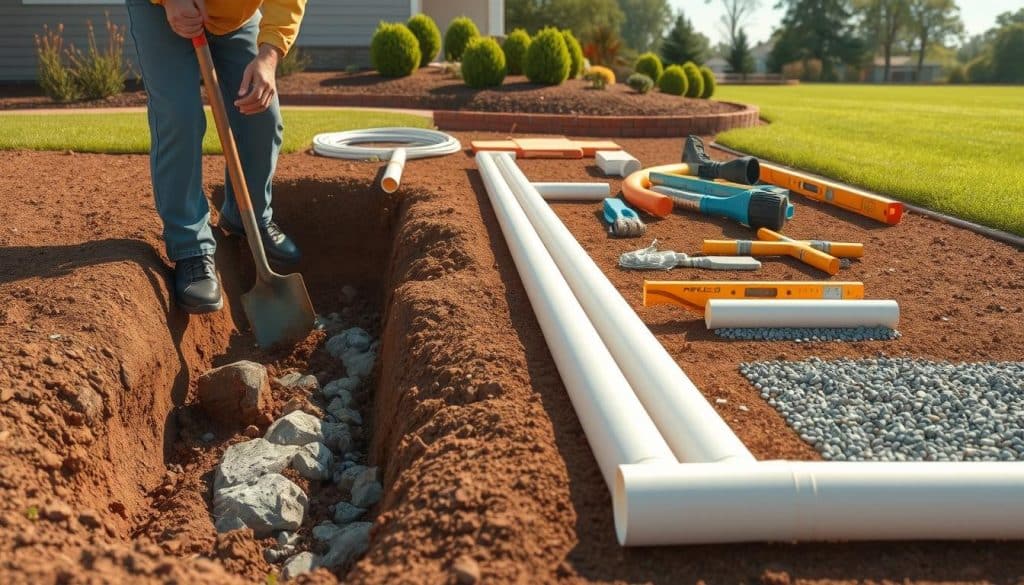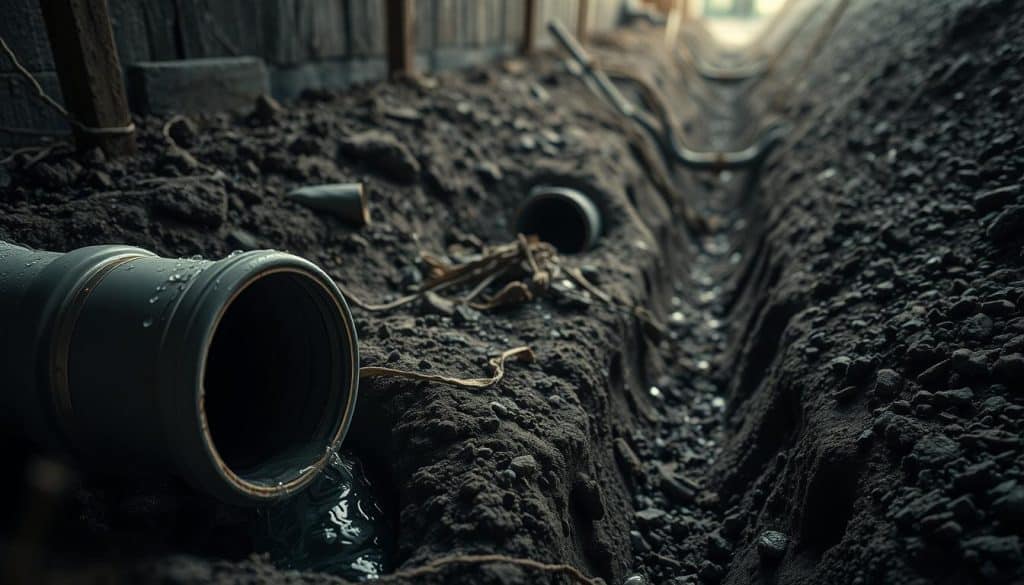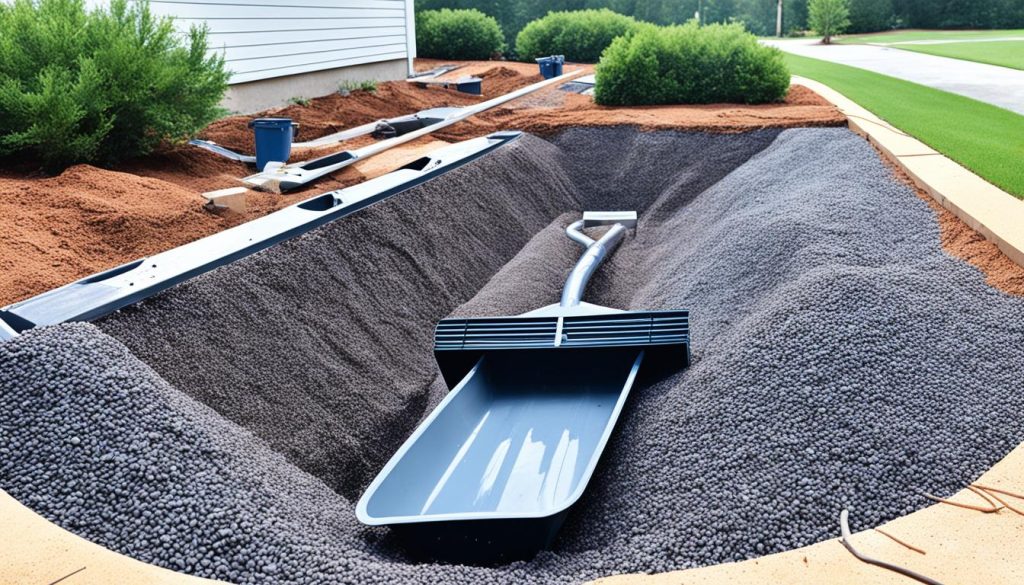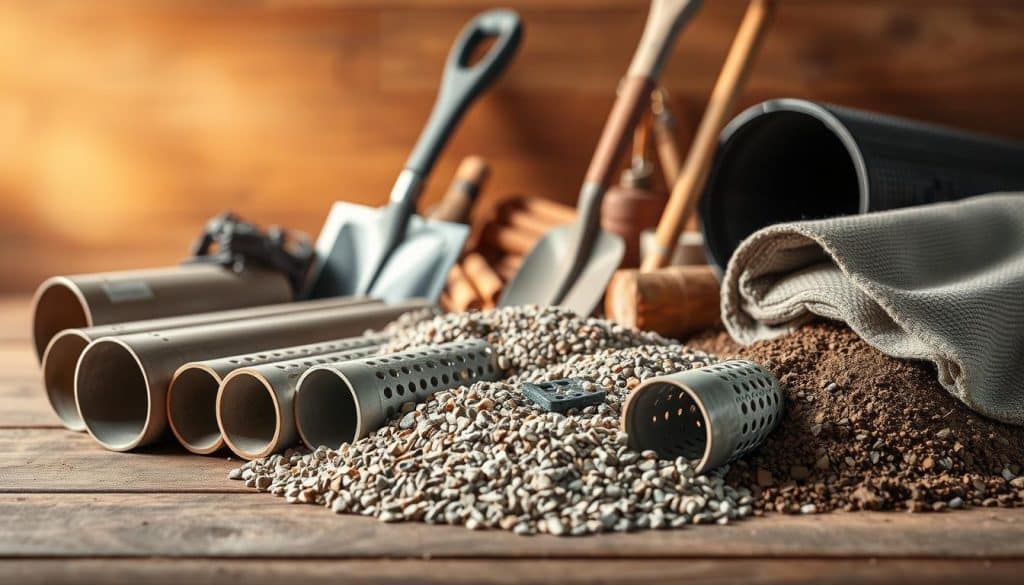Table of Contents
Ever thought about What Materials are Needed for French Drain Installation? Knowing what you need for French drain installation is key. It helps keep your home safe from water damage. The right materials can even boost your property’s value by 10-15%.
In this section, we’ll look at the important parts for French drain installation. We’ll see how each material helps protect your home from moisture issues.
Key Takeaways
- Choosing the right materials is vital for a French drain’s success.
- Medium-sized gravel, ¾ inch to 1 inch in diameter, is best for drainage.
- A 1% downward slope is needed for good drainage flow.
- The cost for materials can start at $241 for a French drain installation.
- Regular maintenance checks prevent future drainage problems.
- The installation depth should be at least 8 inches, but 12-24 inches is better.
Understanding French Drains and Their Function
A French drain is key for managing water. It collects excess water and moves it away from your home’s foundation. It has a trench filled with gravel and a pipe that lets water flow. Knowing about French drains helps homeowners install and maintain them correctly.
What is a French Drain?
A French drain is a trench system that keeps your home dry. It was invented in the mid-19th century by Henry Flagg French. It’s important for homeowners to understand French drains to avoid water problems.
How Does a French Drain Work?
A French drain fights hydrostatic pressure that can harm foundations. Water flows through the pipes and into gravel, then down to an outlet. This keeps water away from your home, protecting it from flooding and damage.

Benefits of Installing a French Drain
French drains do more than just move water. They help prevent expensive foundation repairs. They also protect against soil erosion and keep your property value up. Installing a French drain can save you money on maintenance and extend your foundation’s life.
Essential Materials for French Drain Installation
When you plan to install a French drain, knowing the key materials is important. The right mix of materials ensures the system works well and lasts long. Gravel, PVC pipes, and fabric drainage tiles are critical for moving water away.
Gravel: Importance and Specifications
Choosing the right gravel for your French drain is key. Use gravel that’s about ¾ inch to 1 inch in size. It helps water flow well and prevents clogs. The right gravel keeps your French drain working well for a long time.
PVC Pipe: Choosing the Right Size
For moving water away, you need perforated PVC pipes. For homes, a 4-inch pipe is usually enough. But for more water, you might need a bigger pipe. Picking the right size pipe is important for avoiding future drainage issues.
Fabric Drainage Tile: Why It Matters
Fabric drainage tiles are vital for your French drain’s success. They keep soil and silt out of the pipes. This lets water through but keeps debris out. They make your French drain last longer and work better.
Tools Required for Installation
Installing a French drain needs specific tools. Knowing what tools are needed makes the job easier and safer. Each tool plays a part, from digging to making sure the system works right.
Basic Hand Tools
Basic tools include shovels, rakes, and levels. Shovels help dig trenches. Rakes spread gravel evenly. Levels check if the trench is sloped right for good drainage.
Using these tools well is key to a successful job.
Power Tools for Efficiency
Power tools make the job faster. Trenchers, for example, dig deep trenches quickly. This saves time and effort, making big jobs easier.
Safety Gear for Protection
Safety is very important when installing a French drain. You need gloves, eye protection, and strong shoes. These protect you from sharp tools and debris.
Preparing the Installation Site
Getting ready for french drain installation is key to a good drainage system. Start by checking your property’s drainage needs. Look for spots where water gathers during rain or after snow melts. This helps pick the best spot for the water to flow out.
Assessing Your Property’s Drainage Needs
Start by watching how water moves across your land. Note where water pools and any current drainage systems. Knowing these challenges helps you plan a custom french drain solution.
Marking Out the Drain Placement
After finding the best spot, mark where the drain will go. Use stakes and paint to show where the trench will be. This makes it clear and helps avoid mistakes when digging.
Excavating the Area: Tips and Techniques
When digging, aim for a trench that’s about to inches deep and wide. Make sure it slopes slightly towards the outlet for best results. Keep checking your work to stay on track with the installation.

Installation Process Overview
Installing a French drain can help manage water issues on your property. A structured approach ensures a quick and effective job. This guide will walk you through the process, covering key techniques and best practices.
Step-by-Step Guide to Installing a French Drain
Start by digging a trench that’s 6 inches wide and 18 to 24 inches deep. This depth is key for capturing and moving water effectively. Next, line the trench with a filter fabric to keep dirt out.
Then, add a 2-3 inch layer of gravel. This helps filter water and prevents pipe clogs.
Proper Techniques for Pipe Placement
Put the perforated drain pipe in the trench with holes facing down. This setup captures water well and avoids clogs. Add more gravel around the pipe, making sure it’s 5 inches deep from the top.
Wrap the filter fabric around the gravel to protect the pipe from sediment.
Ensuring Proper Drainage Flow
Fill the trench with topsoil, keeping a slope of about 1%. This ensures water flows well. Make sure the French drain is at least 6 feet from your home’s foundation for best results.
With careful planning, you can finish the job in one to two days. This guide will help you install a French drain successfully.
Common Mistakes to Avoid
Many homeowners face problems when installing French drains. These issues can make the drainage system less effective. Knowing these common mistakes is key to a successful installation. A good French drain installation guide can help avoid these problems.
Incorrect Slope Settings
One big mistake is setting the wrong slope for the drain. A slope of about 1% is needed for water to flow well. This means a drop of 1 inch for every 8 feet. If the slope is too low, water can pool and cause backups.
Using Inappropriate Materials
Choosing the wrong materials is another common error. Using too fine gravel or plastic sheeting instead of filter fabric can clog the system. The best gravel size for French drains is between 3/4 inch and 1 inch. This size helps water move smoothly.
Neglecting Local Drainage Laws
Ignoring local drainage laws can lead to big problems. Each area has its own rules for depth, slope, and materials. Homeowners must follow these laws to avoid legal trouble and costly repairs later.
Post-Installation Maintenance Tips
After installing a French drain, it’s key to keep it in good shape. Regular checks help spot problems early. This way, you can fix small issues before they get big.
Regular Inspections and Cleaning
Regular checks are a must for your French drain. Look for blockages at both ends. Remove leaves and dirt to keep water flowing well.
Flushing the pipe with water can clear out tough clogs. This keeps your drain working right.
Signs of Possible Drain Issues
Watch for water pooling in your yard or slow drainage. These signs mean your drain might be clogged. Catching these early can save you money and hassle.
Repair Tips for Common Problems
Dealing with French drain issues? Start by removing any visible blockages. If the slope is off, adjust it to at least 1% to ensure good drainage.
When to Consult a Professional
Deciding to install a French drain is a big step for homeowners. It’s important to know when to hire a pro. The project’s complexity, like trench depth and length, plays a big role. Also, if you’re dealing with tree roots or rocky soil, a pro’s help is key.
Determining Project Complexity
It’s vital to understand your project’s size and details. A French drain usually needs a trench 18 to 24 inches deep and 6 inches wide. This can be tough to do yourself. Plus, you have to worry about underground utilities.
Before digging, always call 811 to mark utility lines. This step can save you from expensive problems.
Benefits of Professional Installation
Professional installation offers more than just ease. They use special tools that make the job faster. They also know the local rules, making sure your system works right.
A good French drain can cut basement flooding risk by 90%. This means you can relax, knowing your drains will work well for a long time.
Services Offered by Array of Solutions
Array of Solutions offers full installation services for all your drainage needs. They make sure your French drain is built right, with the right slope and pipe placement. This can make your system 30% more efficient than DIY.
With regular checks and upkeep, your French drain can last longer. This means fewer repairs down the road.
Additional Services Offered by Array of Solutions
Array of Solutions is more than just French drain experts. We also offer mold testing and remediation services. Keeping your property safe means no mold, which is key in moist areas. Our team uses the latest methods to find mold early.
Mold Testing and Inspection Services
Testing for mold is the first step. It shows where mold is, so we can act fast. Our certified inspectors find mold that’s hard to see. This stops big problems and health issues.
Mold Removal and Remediation Overview
After testing, we remove mold and its spores. Our methods are safe for your home. Our experts make sure your place is clean and healthy again.
Why Choose Array of Solutions?
Choosing us means getting top-notch service and personal care. Our team offers complete solutions for your home. We handle mold testing and removal together, keeping your home safe. Trust us to protect your home from mold.
Getting in Touch with Array of Solutions
Looking for reliable solutions for drainage problems? You can easily contact Array of Solutions. They offer effective French drain installations to manage excess water. You can call (864) 710-6413 or email scmoldremoval@gmail.com for help with mold removal in South Carolina or other services.
Array of Solutions serves many areas in South Carolina, like Greenville, Spartanburg, and Easley. They make sure quality drainage solutions are available to local homeowners. No matter where you are, their expert team is ready to help with water management.
To book an appointment, just call or email them. It’s easy and quick, so you can get the help you need fast. Whether it’s drainage issues or mold remediation, reaching out to Array of Solutions is the first step to a healthier home.

FAQ
What materials are needed for French drain installation?
How much does it typically cost to install a French drain?
FAQ
What materials are needed for French drain installation?
You’ll need gravel, medium-sized with a diameter of ¾ inch to 1 inch. Also, a perforated PVC pipe, 4 to 6 inches in diameter, is required. Fabric drainage tile helps keep soil and silt out of the pipe.
How much does it typically cost to install a French drain?
Costs vary based on site conditions, drain length, and materials. On average, homeowners spend between $1,000 and $5,000.
Can I install a French drain myself?
Yes, many homeowners can do it themselves. It needs careful planning, the right tools, and knowledge of local laws. For complex jobs, it’s wise to hire professionals.
How do I choose the right type of gravel for my French drain?
Choose gravel that’s medium-sized, between ¾ inch to 1 inch in diameter. This size ensures good water flow and prevents clogs.
What common mistakes should I avoid during installation?
Avoid mistakes like wrong slope settings and using the wrong gravel. Also, don’t ignore local drainage laws. These errors can cause ineffective drainage and legal problems.
How can I maintain my French drain after installation?
Regularly check for clogs or debris at the inlet and outlet. Look for signs like water pooling or slow drainage. Fix these issues quickly.
What tools do I need for French drain installation?
You’ll need basic hand tools like shovels and rakes. Power tools like trenchers can speed up digging for big jobs. Don’t forget safety gear like gloves and eye protection.
What is the function of a fabric drainage tile?
Fabric drainage tile keeps soil and silt out of the pipe. This helps the French drain system work well and last longer.
When should I consider hiring a professional for French drain installation?
Hire a professional for complex jobs, big digging projects, or if you’re worried about underground utilities. They have the skills and tools needed.
Does Array of Solutions provide services beyond French drain installation?
Yes, Array of Solutions also offers mold testing, inspection, removal, and remediation. They help ensure your home is safe and clean.
How can I contact Array of Solutions?
You can start by calling Array of Solutions at (864) 710-6413 or emailing them at scmoldremoval@gmail.com. for help with mold removal in South Carolina or other services.

